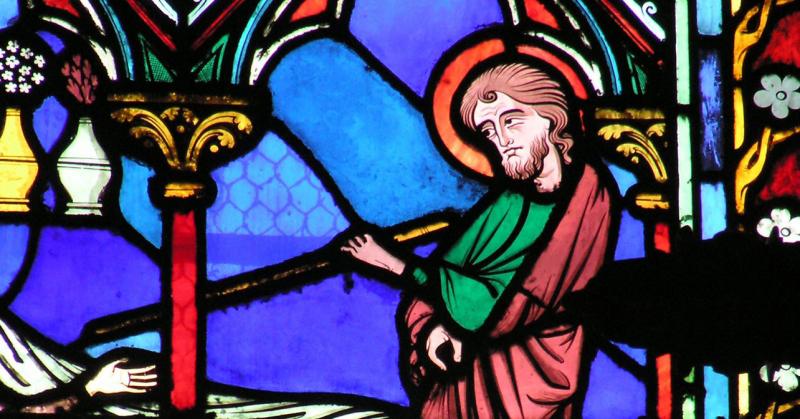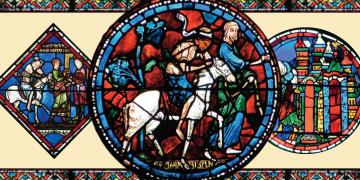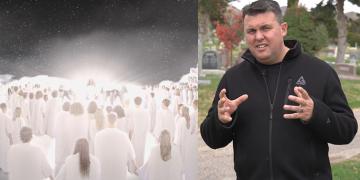You are here
Book of Mormon Central is in the process of migrating to our new Scripture Central website.
We ask for your patience during this transition. Over the coming weeks, all pages of bookofmormoncentral.org will be redirected to their corresponding page on scripturecentral.org, resulting in minimal disruption.
People have long wondered, What happened to Jesus after he was arrested in the Garden of Gethsemane? What kinds of procedures followed, before Caiaphas, members of the Sanhedrin, Pilate, and even Herod Antipas? Were these procedures property conducted under either Jewish or Roman law? And of what could Jesus, an innocent man, be accused and convicted? Was he put to death by Romans under Roman law, or by Jews under Jewish law? Was He accused of political offenses or of religious violations?
Definitive answers to such questions have proven extremely evasive and have generated vast amounts scholarly and popular literature. The trial of Jesus is easily one of the most difficult and controversial subjects in the legal history of the world.
Many possible legal issues present themselves to anyone approaching the trial of Jesus. The most crucial question asks, on what specific ground (or grounds) was Jesus convicted? While it was common in ancient law for defendants to find themselves accused of an array of allegations, as indeed was the case in the actions brought against Jesus, John 18:29–30 holds the key for understanding the legal cause of action that was ultimately brought against Jesus by the Chief Priests before Pilate. John says they accused him of being a kakopoios, literally “an evil (kakon) maker (poios),” which the King James translators rendered as “malefactor,” following the Latin “evil (malus) done (factus; fictor = an image-maker, contriver).” A fascinating course of study, which I have pursued for forty years, thus asks, What did it mean in Jesus’s day to be a kakopoios, and why would the highest Jewish legal officials have told the Roman ruler that they had found Jesus to be a kakopoios?
The following set of notes only scratches the surface of this highly charged historical question. For those interested, here are three of my main publications on this subject. The first is aimed at a general scholarly audience:
John W. Welch, “Miracles, Maleficium, and Maiestas in the Trial of Jesus,” in Jesus and Archaeology, ed. James H. Charlesworth (Grand Rapids, MI: Eerdmans, 2006), 349–383.
The other two were presented at conferences at BYU:
John W. Welch, “The Factor of Fear in the Trial of Jesus,” in Jesus Christ, Son of God, Savior, ed. Paul H. Peterson, Gary L. Hatch and Laura D. Card (Provo, UT: BYU Religious Studies Center, 2002), 284–312
John W. Welch, “The Legal Cause of Action against Jesus in John 18:29-30,” in Celebrating Easter, ed. Thomas A. Wayment and Keith J. Wilson (Provo, UT: BYU, Religious Studies Center, 2007), 157–176.
Here I follow the second of these to explain how the Chief Priests focused on the crime of being a kakopoios (Greek) or a “maleficus” (Latin), which is translated into the King James English as “malefactor” (King James English) in order to state the main concern of theirs about Jesus that would also be the most potent concern for the Romans.
Of course, Jesus was accused of many things. He was he accused of blasphemy in Matthew 26:65–66; Mark 14:63–64. But if blasphemy alone had been the issue, Jesus should have been stoned, which was the usual required mode of execution for blasphemy (see Leviticus 24:16; Acts 6:11; 7:59). And because Pilate and the Romans would have cared very little about a Jewish accusation of blasphemy, scholars have often concluded that Jesus must have been executed on some other ground.
Some have suggested that Jesus must have been convicted of organizing a military revolt against Rome, since he was called “king of the Jews,” as Pilate had his scribes write on the placard placed above Jesus on the cross. But, it is very hard to see much substance to a claim that Jesus was a treasonous revolutionary. He was an unarmed pacifist, a Galilean peasant who said, “All they who take the sword shall perish with the sword” (Matthew 26:52). When asked by Pilate about his kingship, Jesus answered, “My kingdom is not of this world” (John 18:36), and it appears that Pilate was satisfied that Jesus posed little, if any, threat to Rome or to the Emperor Tiberias: “I find in him no fault” (John 18:38). Meanwhile, the Jewish law would not have had jurisdiction over a case of treason against Rome.
The solution that I have found most satisfying is found in the Gospel of John. All readers of the New Testament must choose between (a) relying primarily on John and then secondarily on the Synoptics to fill in the gaps, or (b) primarily on the Synoptics and then secondarily on John. In this case and for a number of reasons, I prefer the former.
Besides the fact that John’s report makes impeccable legal sense, John can be trusted as a witness of these proceedings. For one thing, he was there. He was one of the leading apostles, with Peter and James. He was at Golgatha and would have unforgettably known as much as possible about what was happening and why. Indeed, John 18:15 tells us that “another disciple went in” to Annas’s house. More likely, this disciple was John himself, who was thus an eye witness of these legal proceedings. While the Gospel of John is the most theological of the gospels, it is in many ways also historically authentic, as recent scholarship has quite convincingly argued. John’s account is in fact especially in touch with Galilean and Jewish backgrounds of the life of Jesus in ways that relate to the earliest circumstances of Jesus’s ministry.
In particular, John 18:29–30 reports the exchange between Pilate and the Chief Priests as they brought Jesus to the Praetorium: “Pilate then went out unto them, and asked, What legal accusation do you bring against this man? They answered and said unto him, If he were not a kakopoios, we would not have turned him over to you” (my translation). The critical question then becomes, what did the Chief Priests mean by kakopoios?
Indeed, the Greek work kakopoios, which (like its closely related Latin word, maleficus), particularly in legal contexts, can mean “magician” or “sorcerer.” To understand how ancient people generally, and the leaders of the Jewish establishment in particular, would have reacted to Jesus and his miracles, modern readers must understand the positive and negative attitudes of ancient Jews and Romans towards activities that involve the supernatural, divination, conjuring, or magic. Both the Romans and the Jews had strict laws that punished magicians, sorcerers, fortune tellers, diviners, those in contact with spirits, and also miracle workers.
Most relevant to the trial of Jesus is the biblical law that imposes the death penalty on those who use miracles (signs or wonders) to lead people into apostasy (to go after other gods): “If there arise among you a prophet, or a dreamer of dreams, and giveth thee a sign or a wonder, and the sign or the wonder come to pass, whereof he spake unto thee, saying, Let us go after other gods . . . that prophet or that dreamer of dreams shall be put to death” (Deuteronomy 13:1–2, 5). Of course, Jewish law recognized that there were good uses of supernatural powers as well as bad. Jewish attitudes toward magic were mixed. On the one hand there was the famous contest between Moses and Pharoah’s magicians. And King Saul visited the witch of Endore. But Exodus 22:18 commands, “Thou shalt not suffer a witch [either male or female] to live.” The Jews took magic seriously enough that in order to qualify as a member of the Sanhedrin (according to Babylonian Talmud, Sanhedrin 17a), one was required to be able to distinguish between good miracle working and evil trafficking with ghosts, intoxicating “familiar spirits,” or other gods. Although Jesus’ miracles all produced good results, his opponents could use the legal concerns to attack and prosecute him.
And in addition, Roman law also banned certain uses of magic and divination. Empire-wide decrees adopted in the years 11 and 16 AD, which were issued during Jesus’s own lifetime, elevated suspicions about any rogue invocations of supernatural powers. Roman law and society at that time considered magicians, along with brigands, pirates, robbers, astrologers, philosophers, and prophets, to be enemies of the Roman order. For these people, gods were everywhere, good and evil; and thus they took unseen spirits and demons very seriously as constant potential threats. Especially when combined with maiestas (anything that insulted, suborned or threatened the Emperor), failing to punish any such use of supernatural powers would especially make a person “no friend of Caesar” (as the Chief Priests reminded Pilate in John 19:12). And here we can see the main Roman concern that the Chief Priests used to capture Pilate’s attention.
And, although for different reasons, Caiaphas and the Chief Priests also were most concerned about Jesus’ miracle working. While we as followers of Jesus have no reason to think that He ever used his powers to harm anyone, people in Jesus’ day did not know where He would stop. If he could still the storm, then he could cause earthquakes (the most likely way in which could instantly destroy the temple), and his words about the destruction of the temple were alleged (however wrongly) to be an actual threat against the temple: “We heard him say, I will destroy this temple” (Mark 14:58).
Legal debates had in fact ensued over the miracles of Jesus. People wondered: By whose power does he do this? (compare Acts 4:7). In Mark 3:22, Scribes (legal officials) were brought all the way to Galilee from Jerusalem to give their legal opinion in the case of driving a legion of devils out of a possessed man. People accused Jesus: “He hath Beelzebub [Satan], and by the prince of the devils casteth he out devils.” What was going on in that case was not a theological debate or a popular news report, but a legal investigation which could have resulted in an allegation with dire legal implications.
This same debate continued in Jerusalem. John 10:19–21 tells us that “there was a division therefore again among the Jews for these sayings. And many of them said, He hath a devil, and is mad; . . . Others said, These are not the words of him that hath a devil. Can a devil open the eyes of the blind?”
As we have discussed previously, the final miracle that tipped the scales against Jesus was the raising of Lazarus. That miracle raised legal issues that could not be ignored, and “from that day forth they took counsel together for to put him to death” (John 11:53). This unified the two parties that controlled the Sanhedrin: “Now both the chief priests and the Pharisees had given a commandment that if any man knew where [Jesus] were, he should shew it, that they might take him” (John 11:57). And Lazarus likewise, “because by reason of him many of the Jews went away and believed on Jesus” (John 12:10–11).
Seen against this legal background, it is hard to imagine how Jesus’s miracle working would not have been the dominant factor that galvanized the Chief Priests against him. While this factor is occasionally mentioned by commentators, the underlying concern or cause of action is not usually given much attention. The main reason for this disregard is that no formal accusation of maleficium appears in Matthew, Mark, or Luke. But the case as reported in John deserves greater weight, attention, and authority. So, let’s take a closer look at John 18:30.
While sometimes the terms malefactor, maleficus, kakopoios, or kakon poion can be understood in a general sense of just being “a bad guy” or “evil doer,” the context here strongly indicates that this term is being used here in a specific way. Here are ten reasons why the word “malefactor” in John 18:30 should be taken as having a technical legal meaning. These linguistic or circumstantial reasons give grounds upon which to conclude that the legal cause of action brought by the Chief Priests against Jesus, as they tried to turn him over to Pilate, was that he was an illegal miracle worker or magician using illicit powers to threaten the public order.
- The legal setting. Ordinary words carry technical legal import when used in a judicial context. English words such as action, motion, bench, or arise all have regular meanings in ordinary speech, but they have a legal meaning when they are being spoken in a court, as is the case here.
- The legal request. When Pilate asked, “What sort of accusation do you bring against this man?” he was not saying, “What’s going on here?” His words call for a legal response stating a specific cause of action. He would expect the Chief Priests to formulate their reply in terms of recognizable causes of action under Roman law.
- The logic of the exchange. In the synoptic Gospels (of which John presumably was aware), Pilate is said to have asked, “What kakon [bad or evil thing] has he done?” (Matt 27:23; Mark 15:14; Luke 23:22). In their discourse with Pilate, if John were to have the Chief Priests simply respond, “Oh, we found him doing kakon,” their response would be circular, evasive, and perhaps even insulting. Their answer, that they had found Jesus to be a kakopoios, is best understood as being a specific reply and not simply a repetition of the question back to the magistrate.
- The strong meaning of the word. Ancient astrological treatises, magical papyri, and other documents use the word kakopoios to describe bad mystical agents. In an emotionally charged setting, such as the hearing before Pilate, speakers or writers do not typically use strong or technical words in a weak sense.
- A legal characterization of early Christians. The early Christians themselves were seen by others as being involved in magic. Suetonius, in his biography of Nero (de Vita Caesarum, 6.16) states that Christians in their first century were accused of being involved in superstitionis novae ac maleficae, a label that implies legal charges of magic.
- Contemporaneous legal prosecutions of other miracle-workers. Apollonius (who coincidentally was raised in Tarsus about the same time as was Paul) was another miracle-worker in the first century. He was “tried for his life by Domitian,” who accused Apollonius among other things “of divination by magic for Nerva’s benefit,” and his emphasis “on supernatural revelations inevitably led to his being accused of magical practices” on other occasions as well.1
- Jesus and exorcism and wonder working. Jesus and his disciples were indisputably depicted as exorcists, the positive implications of which have been thoroughly explored in other contexts.2 But if used for improper purposes in an open and notorious fashion, even exorcisms would have produced legal trouble. Carl Kraeling has argued persuasively that people generally said of Jesus that he “has a demon,” meaning that he “has a demon under his control,” a concept commonly applied in the ambient culture to people having access to “the spirits of persons who had died a violent death [such as the spirit of John the Baptist].”3 After Jesus healed a man with a withered hand on the Sabbath and was then accused by people in the synagogue, he asked them, “Is it lawful to do good on the Sabbath days, or to do evil (kakopoiēsai),” and his accusers “held their peace” (Mark 3:4). Obviously, it was unlawful any time to do magical evil on any day.
- Use in 1 Peter. The only other place where the word kakopoios appears in the New Testament is in Peter’s first epistle, where it occurs twice, likely referring to a person “guilty of legally defined crimes.”4 Peter knew of people calling Christians kakopoioi, but he was confident that judges and others would see their good works, glorify God, and convict them not as magicians or “evil makers” but as “good makers” (1 Peter 2:12, 14). Here the label of “evil makers” was intended by outsiders to be deeply pejorative, not just mildly insulting. Even more definitively in 1 Peter 4:13–16, Christians were exhorted to share the suffering of Christ, but not as a murderer, a thief, a kakopoios, or as a fourth kind of offender (the specific nature of which is indeterminable). Clustered together with the first two very serious offenses in this list, the word kakopoios points to a particular crime of seriously unacceptable magnitude.
- Early Christian attestations. Some early Christians, such as Lactantius in the late third or early fourth century, openly acknowledged that the Jews had accused Jesus of being a magician or sorcerer.5 Christians did not answer by arguing that this word in John 18:30 should be understood in some weak sense. They answered by arguing that the astonishing miracles of Jesus were acceptable because the prophets had predicted them.
- Confirmations from early Jewish sources. Evidence of Jewish opinion (also around the third century) comes from the following passage from the Babylonian Talmud, Sanhedrin 43a: “On the eve of the Passover Yeshu [the Nazarine] was hanged. For forty days before the execution took place, a herald went forth and cried, ‘He is going forth to be stoned because he has practiced sorcery and enticed Israel to apostasy. Anyone who can say anything in his favor, let him come forward and plead on his behalf.’ But since nothing was brought forward in his favor he was hanged on the eve of the Passover.” Notice that the raising of Lazarus and the Sanhedrin trial led by Caiaphas in John 11:47–57 would have happened about forty days before Passover.
Ultimately, however, even Pilate found no such cause of action (or any other) against Jesus, and so he held: “I find in him no fault,” or in other words “I recognize no legal cause of action against him” (John 18:38, my translation). Pilate was satisfied that Jesus of Nazareth had not yet broken any Roman law. But obviously Jesus had extraordinary powers. and one can see that some might have seen that as possibly being turned in some way against Rome or Tiberius Caesar. Thus, Pilate was apparently fearful enough about the situation that he was willing to allow the Chief Priests to move ahead, accompanied by Roman soldiers who were going to crucify two others that morning in any event.
All of this textual and contextual analysis is corroborated by the fact that, during the next hundred years, his having been a miracle worker and wonder worker was seen as a dominant part of Jesus’ public reputation. This is evident from the writings of Josephus, both in Greek and Slavonic. For example, the Slavonic version of Josephus states: “And [Pilate] had that wonder-worker brought up, and after instituting an inquiry concerning him he pronounced judgment: ‘He is [a benefactor, not] a malefactor, [nor] a rebel, [nor] covetous of kingship.’ [And he let him go; for he had healed his dying wife.]”6
Moreover, the earliest extant Christian art offers further witness of the popular reputation that Jesus had as a wonder worker, not only among his detractors, but also his followers. Pre-Constantinian images of Jesus depict him as a miracle worker more often than in any other pose. The most common compositional element of these images shows Jesus holding a rod or wand, representing the divine power with which he performs his supernatural feats. It would be several centuries after the death of Christ before the cross or the passion narratives became main subjects of Christian art.
Instead, the raising of Lazarus (John 11:1–43), the raising of Jairus’s daughter (Mark 5:22–43; Luke 8:41–56), the miracles of loaves and fishes (Mark 6:38–44; 8:5–19; Matthew 14:17–19; 15:34–36; Luke 16:9–10; John 6:9–13), and the turning water into wine (John 2:1–11) were the most popular narratives in the ministry of Jesus that were depicted in the first few centuries.7 As one scholar has noted, “To such Christians, the life of Christ consisted simply of a series of miracles.”8 And in depicting these miracles, Jesus touches the body of the deceased, the loaf-filled baskets, and the water-filled amphora with a wand, symbolizing his divinely wondrous powers.
Although found in several locations, the majority of these images are found in the Christian funerary sculptures or paintings in the Roman catacombs—a 12-mile underground labyrinth of niches, alcoves, and passageways beneath Rome. In that iconic burial place, graves were often decorated with religious motifs, sometimes quite elaborately. The resurrection of the deceased was metonymically promised by scenes of the miracles of Christ, as well as by the sign of Jonah being rescued from the whale, and the divine deliverance of Shadrach, Meshach, and Abednego from the fiery furnace.
Ancient artists often added the detail of Jesus holding a staff or a wand in depicting the Gospel miracle stories (See Figures 11, 12, 13). This was because of the popular correlation of wands with magicians. In Homer’s Odyssey, for example, Circe—the magician daughter of Helios—is depicted working her magic with a wand when she transforms a group of people into pigs. In Roman mythology, Mercury was one of the gods who escorted souls to and from the afterlife. Just as Mercury is depicted holding his golden wand to lead the dead back to life, so to Jesus is shown supernaturally bringing people back to life with a wand or staff representing His divine power.9
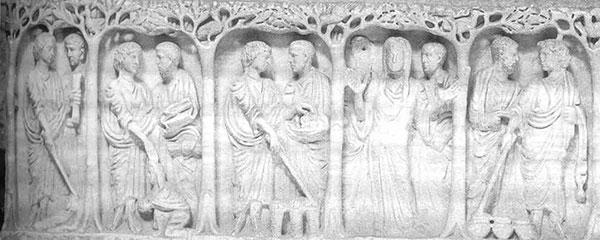
A family sarcophagus showing series of miracles of Jesus with a wand, for men, women and children.
Photo by John W. Welch.
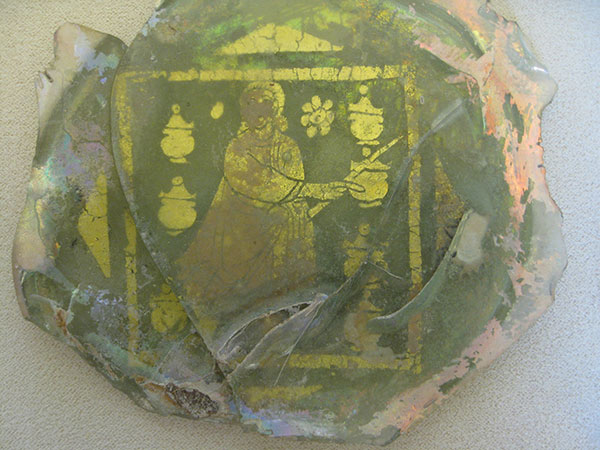
A gold-leafed glass plate of Jesus changing water into wine with a wand. Photo by John W. Welch.
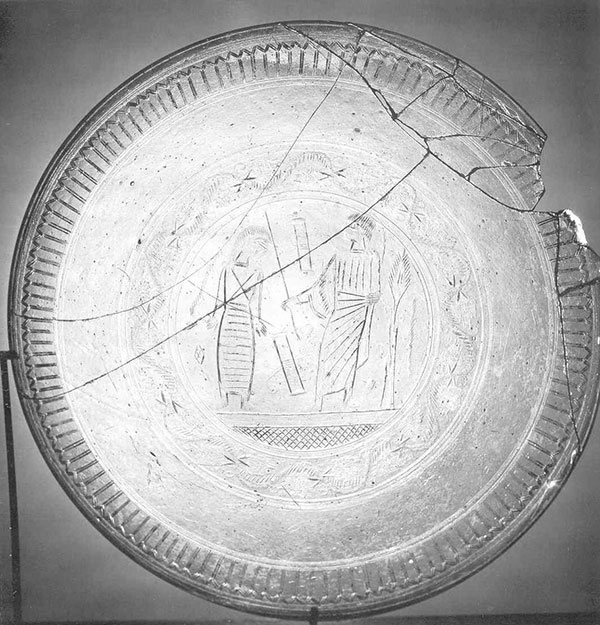
A clear glass plate with etching of Jesus raising Lazarus. Photo by John W. Welch.
Thus, one may wonder why the factor of fearful magic has not been emphasized previously in scholarly or religious literature about the trial of Jesus. I would suggest at least three main reasons:
First, few secular scholars want to allow that the miracles of Jesus really happened. And if they did not happen, of course, they could not have been a factor in the historical trials of Jesus before the Sanhedrin and Pilate. But if those miracles did happen, it is hard to see how they could not have been a dominant factor in the case of the Chief Priests against Jesus of Nazareth.
Second, faithful Christians today, of course, generally do not want to associate the innocent Jesus with any suggestion that he was a trickster. But the New Testament itself invites readers to recognize the difference between good miracles and bad magic. The difference is definable by results. Jesus himself said, “By their fruits ye shall know them” (Matthew 7:20), and convincingly asked, “Can Satan drive out Satan? And if a kingdom be divided against itself, that kingdom cannot stand” (Mark 3:23–24). Thus, Christians should celebrate, not shy away from the miracles of Jesus.
Third, critical scholars in the twentieth century gave more historical weight to the accounts in Matthew, Mark and Luke than to those in John. But in light of the fact that all three of the synoptic gospels report that Pilate asked, What kakon (evil) has he done?” (Matt 27:23; Mark 15:14; Luke 23:22), the formulation by the Chief Priests of the legal cause of action against Jesus in John 18:30 becomes all the more significant. The charge that Jesus was a kakopoios (a malificus, magician, or wonderworker) raises a connecting ground, not only between all four New Testament Gospels, but also between the Jewish leaders and their Roman procurator.
Of course, it would help if the world accepted the Book of Mormon, which long ago revealed that even after all his mighty miracles “they shall consider him a man, and say that he hath a devil, and shall scourge him, and shall crucify him” (Mosiah 3:9). It seems to me, as the Book of Mormon makes quite clear, that it was his miracles that lead to Jesus’s scourging and crucifixion. His mighty miracles forced the issue, then as now, requiring people to ask, By what power did Jesus do these things? If by the power of God, then he should be believed, accepted and followed; but if by the power of Beelzebub, then he should be feared, discounted and eliminated.
Jesus certainly came with power. He was the creator of the world. He was good enough, wise enough, and powerful enough to bring to pass the salvation, immortality, and eternal life of all mankind. If he could raise Lazarus from the dead, he could control many other life and death situations, in this world and in the world to come. His powers were also sufficiently in control of all that needed to happen as he came into this world and as he went out of it (see John 10:18). He came to win the cosmic battle against death and hell, to engage the powers of evil, to drive out devils from paralytics and demoniacs, to heal the sick, to overwhelm despair with hope, to raise the dead, and to cast Satan eternally out. This makes one wonder: How, indeed, could he do all of this and not in some opposing minds find himself seriously accused of dealing with and in the realms of the preternatural?
Further Reading
John W. Welch, “Miracles, Maleficium, and Maiestas in the Trial of Jesus,” in Jesus and Archaeology, ed. James H. Charlesworth (Grand Rapids, MI: Eerdmans, 2006), 349–383.
John W. Welch, “The Factor of Fear in the Trial of Jesus,” in Jesus Christ, Son of God, Savior, ed. Paul H. Peterson, Gary L. Hatch and Laura D. Card (Provo, UT: BYU Religious Studies Center, 2002), 284–312
John W. Welch, “The Legal Cause of Action against Jesus in John 18:29-30,” in Celebrating Easter, ed. Thomas A. Wayment and Keith J. Wilson (Provo, UT: BYU, Religious Studies Center, 2007), 157–176.
- 1. Cramer, Astrology in Roman Law and Politics, 222–223.
- 2. Smith, Jesus the Magician; R. Shirock, “Whose Exorcists Are They?” JSNT 46 (1992): 41–51; C. K. Barrett, The Holy Spirit and the Gospel Tradition (London: SPCK, 1947) ch. 4.
- 3. C. H. Kraeling, “Was Jesus Accused of Necromancy,” JBL 59 (1940): 153–157.
- 4. J. H. Elliott, 1 Peter (New York, NY: Doubleday, 2000), 468. When Luke calls the two other criminals crucified with Jesus “malefactors” (Luke 23:32), the Greek word he uses is kakourgos, not kakopoios. Luke’s word refers to “robbers,” and it must mean something different to Luke than what kakopoios means to John, or else we must imagine that the Jews in John 18:30 were accusing Jesus of being a “robber,” an allegation that lacks any plausible basis.
- 5. Lactantius, Divine Institutes, 5, 3; in Patrologia Latina 6.560–561.
- 6. Josephus, War IV-VII, trans. H. St. J. Thackeray, LCL (Cambridge, MA: Harvard University Press, 1928), pp. 648–650 (brackets retained as included in this translated source; emphasis added).
- 7. See Thomas F. Matthews, The Clash of the Gods: A Reinterpretation of Early Christian Art, Rev. ed. (Princeton, NJ: Princeton University Press, 1993), 54–91; and Robin Margaret Jensen, Understanding Early Christian Art (New York, NY: Routledge, 2000), 64–93.
- 8. Matthews, Clash of the Gods, 59.
- 9. For Circe, see Odyssey 10.293, 388; Virgil Aeneid, 7.189–91; Ovid, Metamorphoses, 14.278, 413. For Mercury, see Odyssey, 24.1; Virgil, Aeneid, 4.242; and Prudentius, Contra Symachum, 1.89–91 all cited in Matthews, Clash of the Gods, 58–59. I thank Josh Probert for his research on early Christian art.
Subscribe
Get the latest updates on Book of Mormon topics and research for free


